For more than 200 years, the US Mint has created American coins, some of which are extremely prized. For instance, the Winged Liberty Head dime, more commonly referred to as the Mercury dime, is regarded by many coin collectors as one of the most exquisite coins ever produced.
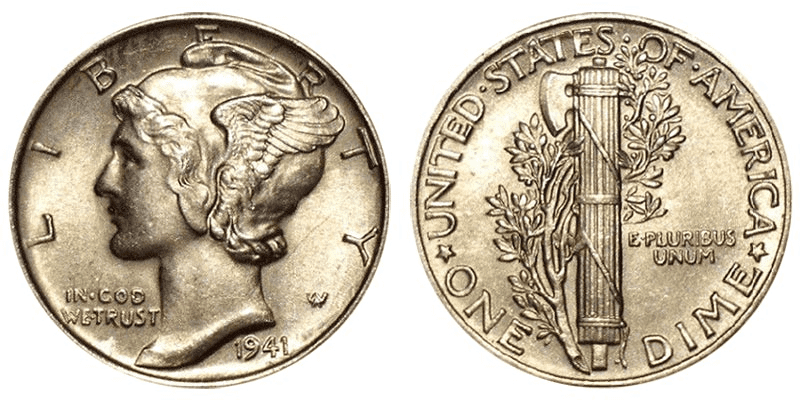
Whenever you decide to start a collection, it is essential to know that these silver coins were produced for nearly 30 years, from 1916 to 1945. So, although most older pieces in excellent condition are rare, the 1941 Mercury dime’s value is still quite low because of its large mintage.
Nevertheless, you can’t have a collection without the 1941 Mercury dime, right? Read on to learn more about this beautiful coin below.
What Is the 1941 Mercury Dime Made Of?
The 1941 Winged Liberty Head (Mercury) dime has a reeded edge and a metal composition of 90% Silver and 10% Copper. The 17.90-millimeter coin weighs 2.50 grams.
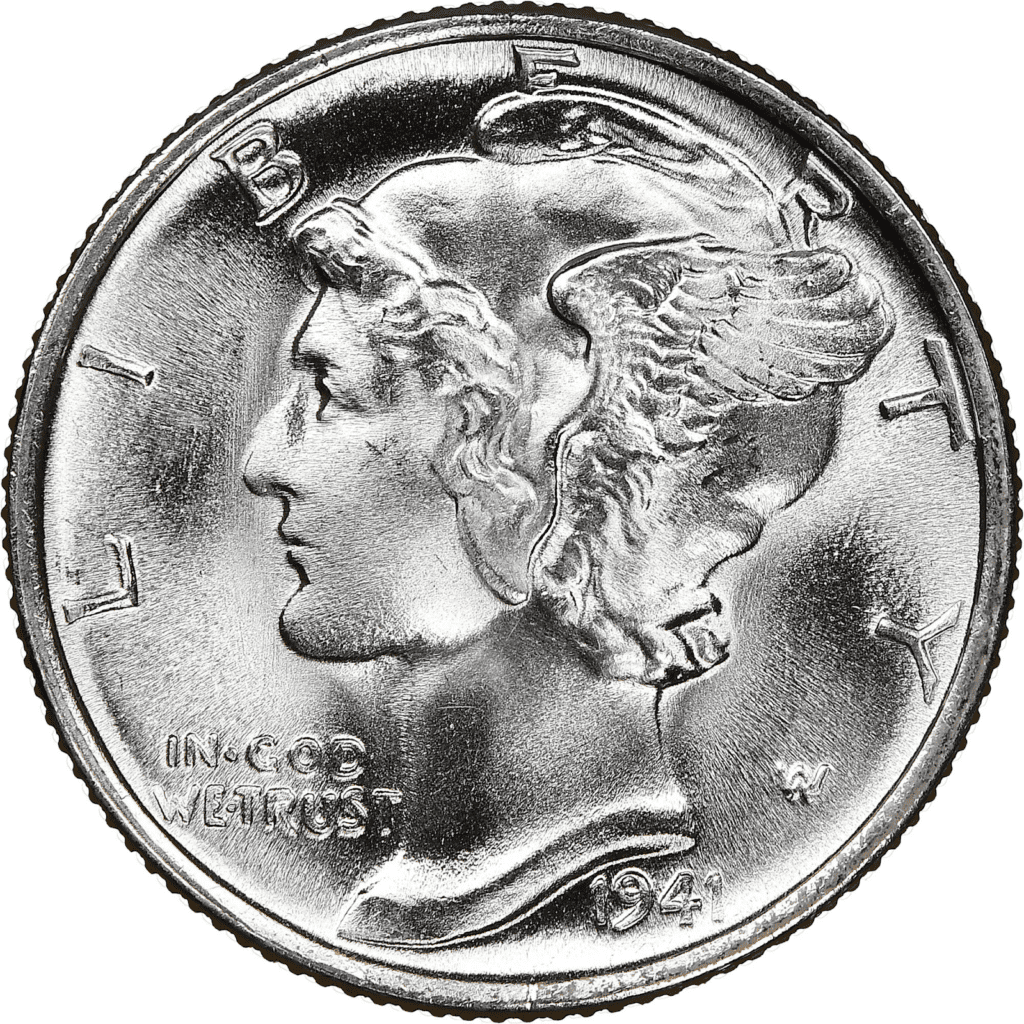
Adolph Alexander Weinman designed the coin’s unique obverse. It features Lady Liberty wearing a Phrygian cap with wings on both sides. However, many people mistook it for the Roman god Mercury, giving the new coin its enduring reputation.
The word LIBERTY, the year 1941, and the designer’s initials, AW, are all featured in the exquisite design. The famous adage, IN GOD WE TRUST, is inscribed on the left side of the bust’s neck.
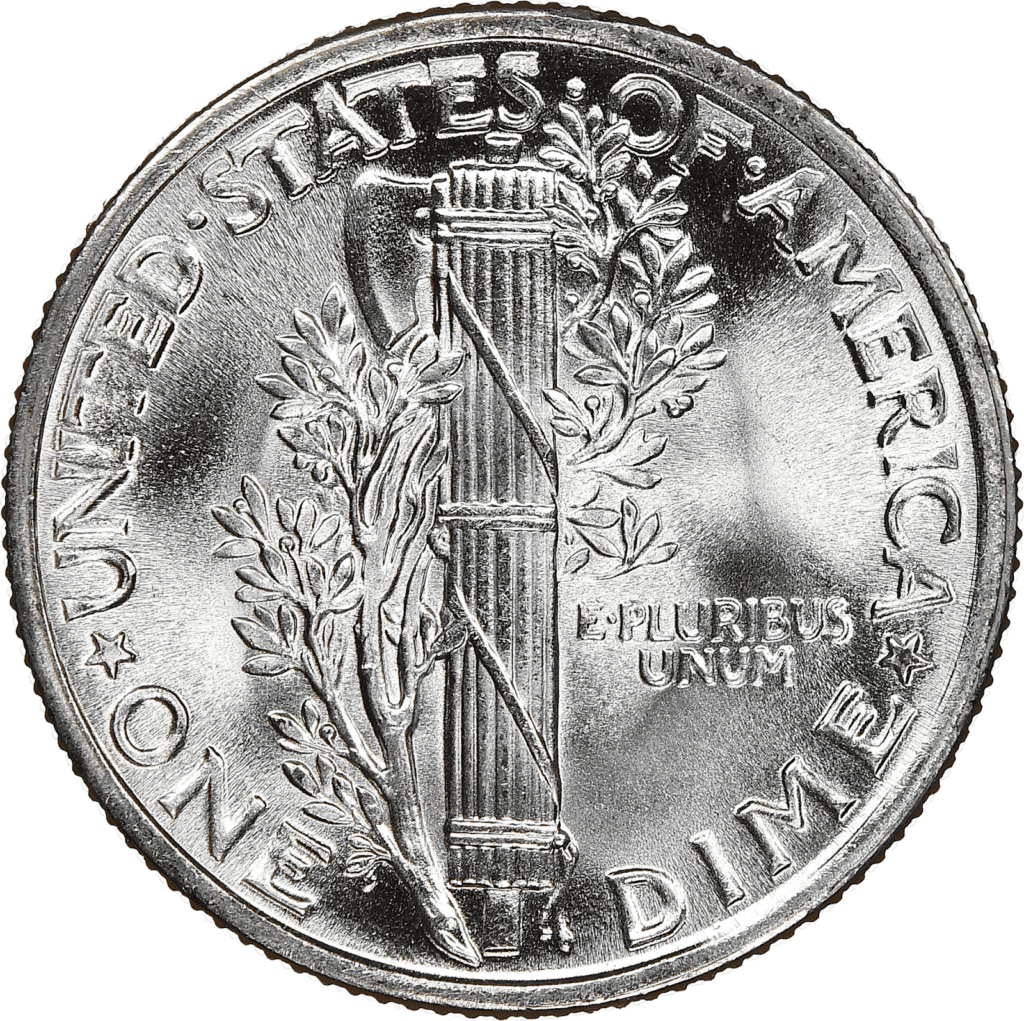
If you check the coin’s reverse, you will find a fasces, which stands for strength and togetherness, positioned in the center. In it, you will see an ax strengthened with a bundle of sticks wrapped in an olive branch, the universal sign of peace.
The words UNITED STATES OF AMERICA (above) and the denomination ONE DIME (below) are inscribed along the coin’s rim. You can find the coin’s mint mark below the olive branch for the coins minted in Denver and San Francisco. The Philadelphia coins do not bear any mint mark.
1941 Mercury Dime Varieties
The 1941 Mercury dime was produced soon after the attack on Pearl Harbor. Collectors enjoy this coin because of its historical relevance, although it has a relatively low value regardless of the mint that produced it.
The Treasury discontinued these beautiful coins in 1945 in favor of a new model that paid tribute to the late President Roosevelt. Nevertheless, the Mercury dime is still one of the most sought-after American coins in modern times. These were reissued in 2016 by the US Mint to mark its centennial.
Here are the Mercury dime varieties minted in 1941:
| Variety | Mint Location | Mintage |
| 1941 D Mercury Dime | Denver | 45,634,000 |
| 1941 S Mercury Dime | San Francisco | 43,090,000 |
| 1941 Mercury Dime | Philadelphia | 175,090,000 |
| 1941 Proof Mercury Dime | Philadelphia | 16,557 |
| Total | 263,830,557 |
1941 D Mercury Dime
Edge: Reeded
Mint Mark: D
Place of minting: Denver
Year of minting: 1941
Face Value: $0.10 (ten cents)
Price: $2.20 to $6.03 (circulated condition)
Quantity produced: 45,634,000
Designer: Adolph Alexander Weinman
Composition: 90% Silver and 10% Copper
Mass: 2.50 grams
Diameter: 17.90 mm
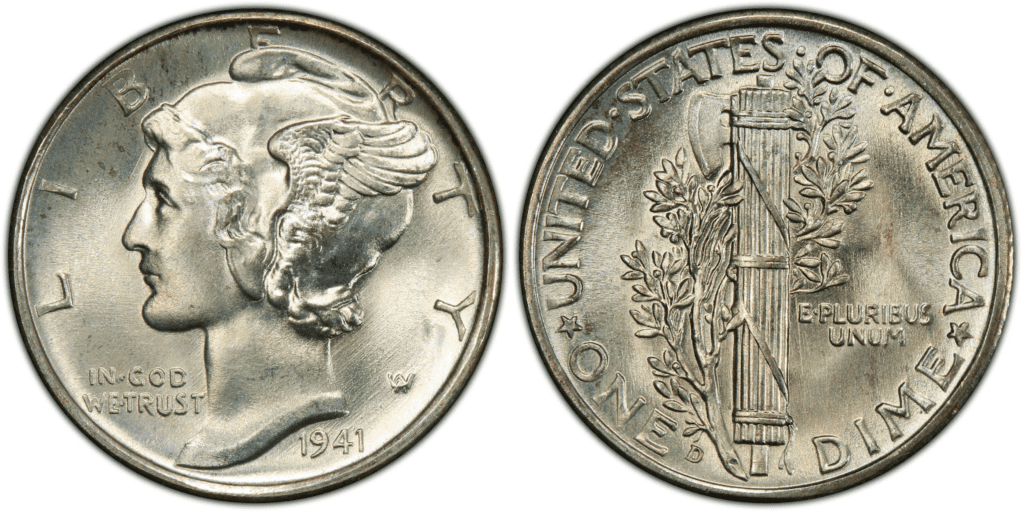
The 1941 D Mercury dime is widespread in all grades through MS-67 FB because the Denver Mint produced more dimes this year than it did the year before. A higher number of these coins have Full Bands, and this pattern persisted until the rest of the series. Both double-die and repunched mintmark versions of 1941 D Mercury dimes are abundant. The better ones stand out and are particularly well-liked by collectors.
If you find a 1941 Mercury dime in circulation, you should know that the NGC Price Guide estimates its value at $2.50 and $4.75 (as of January 2023). However, if you sell one in pristine, uncirculated condition on the open market, you could make up to $500!
1941 S Mercury Dime
Edge: Reeded
Mint Mark: S
Place of minting: San Francisco
Year of minting: 1941
Face Value: $0.10 (ten cents)
Price: $2.20 to $6.03 (circulated condition)
Quantity produced: 43,090,000
Designer: Adolph Alexander Weinman
Composition: 90% Silver and 10% Copper
Mass: 50 grams
Diameter: 90 mm
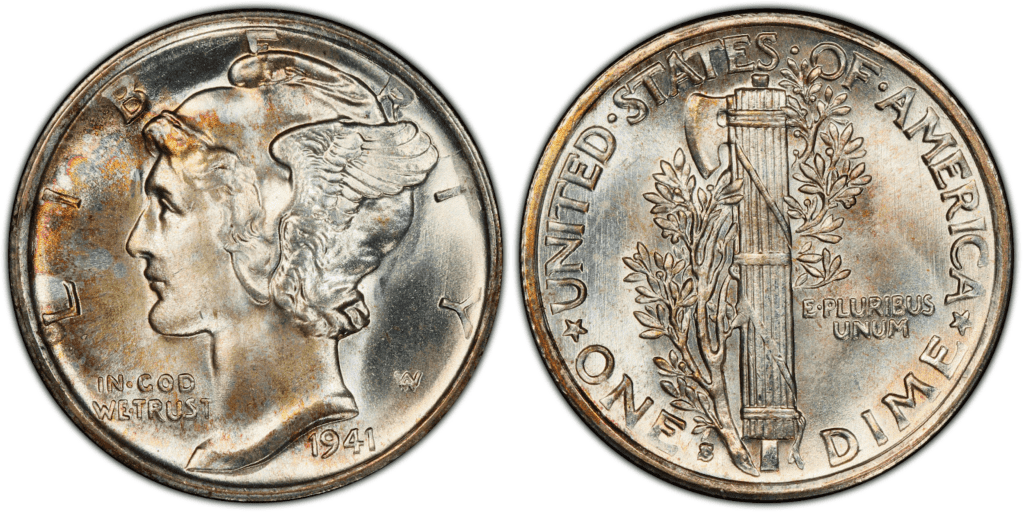
The 1941 production of dimes at the San Francisco Mint more than doubled that of the previous year. Although many examples are up to the grade of MS-67 FB, Full Bands coins make up a small portion of the survived specimens.
If you go to the NGC website, you will find that their Price Guide has estimated the 1941 Mercury dime to cost between $2.50 and $4.50 as of early this year. But you could make more on the open market. If you have one in pristine and uncirculated condition, you could make up to $700!
1941 P Mercury Dime
Edge: Reeded
Mint Mark: no mint mark
Place of minting: Philadelphia
Year of minting: 1941
Face Value: $0.10 (ten cents)
Price: $2.20 to $4.99 (circulated condition)
Quantity produced: 175,106,557
Designer: Adolph Alexander Weinman
Composition: 90% Silver and 10% Copper
Mass: 2.50 grams
Diameter: 17.90 mm
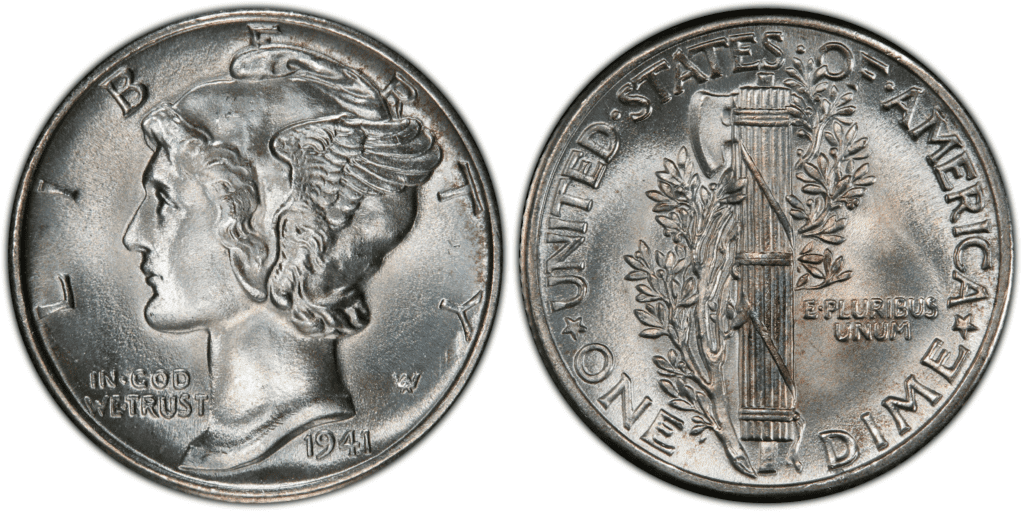
An increase in the production of military materials for its allies was abundantly seen in the American economy in 1941. Due to the enormous demand for new coins caused by this increased activity, extremely high mintages would continue to be the standard until 1945.
All 1941 P Mercury dimes up to MS-67 FB grades are relatively common. However, collectors should be careful when shopping. One should look for examples struck from new, sharp dies because high mintages usually indicate overused dies.
The enormous number of dies used should have resulted in many doubling dies. However, only a small number of such kinds are known to have this error.
If you go to the NGC website, you will find that their Price Guide has estimated the 1941 Mercury dime to cost between $2.50 and $4.50 as of early this year. But you could make more on the open market. If you have one in pristine and uncirculated condition, you could make up to $700!
1941 P Proof Mercury Dime
Edge: Reeded
Mint Mark: no mint mark
Place of minting: San Francisco
Year of minting: 1941
Face Value: $0.10 (ten cents)
Price: $132 to $144 (or more)
Quantity produced: 16,557
Designer: Adolph Alexander Weinman
Composition: 90% Silver and 10% Copper
Mass: 2.50 grams
Diameter: 17.90 mm
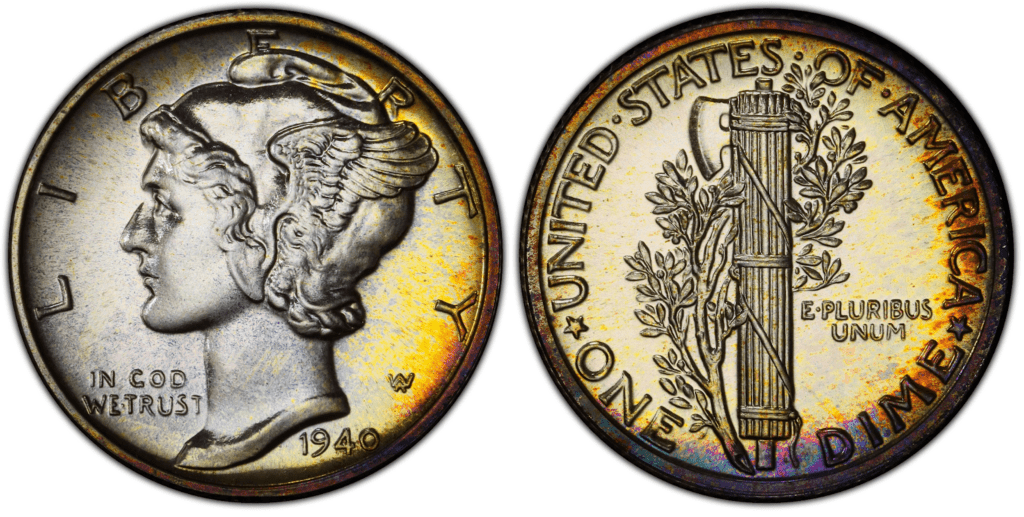
The Philadelphia mint produced 16,557 proof Mercury dimes in 1941 in addition to the regular strikes. You should set aside $100 to $300 per piece because these coins are often worth more than those meant for circulation.
If you go to the NGC website, you will find that their Price Guide has estimated the 1941 Mercury dime to cost between $2.50 and $4.50 as of early this year. But you could make more on the open market. If you have one in pristine and uncirculated condition, you could make up to $700!
List Of 1941 Mercury Dime Errors
Did you know that if your coin has an error, it could significantly increase its worth? Yes! So, you should be extra observant when collecting 1941 Mercury dimes. Keep a coin magnifying glass with you to ensure that you check even the minutest details for possible errors.
Here are some of the errors that you may find on your 1941 Mercury dimes:
Doubled Die Obverse (DDO)
When a portion or the whole image in the coin die is doubled, it produces doubled die coins. The coin features two identical pictures that are slightly offset from one another. Inaccuracies in the die hubbing process lead to this doubling.
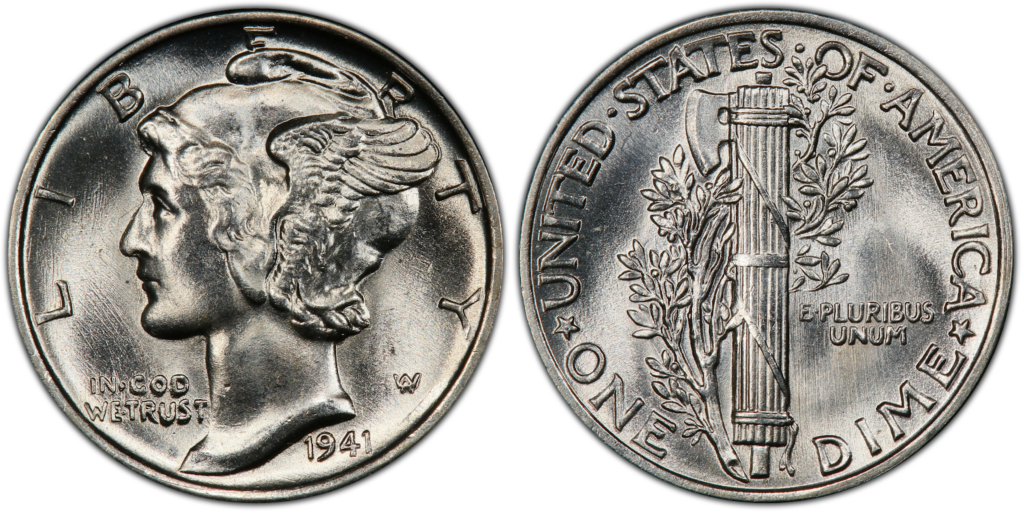
Large “S” Mint Mark
Most 1941 S Mercury dimes had the traditional Small “S” mint mark from 1917–1940. However, a new, larger S emerged in 1941. Because of its broad lower serif, which resembles the flared bell of a trumpet, it is commonly referred to as the Trumpet Tail.
Although Mint State pieces are rare enough to fetch a premium, circulated copies of this mint mark are not uncommon. There are several known repunched mint mark (RPM) variations, all but one of which feature the Small S.
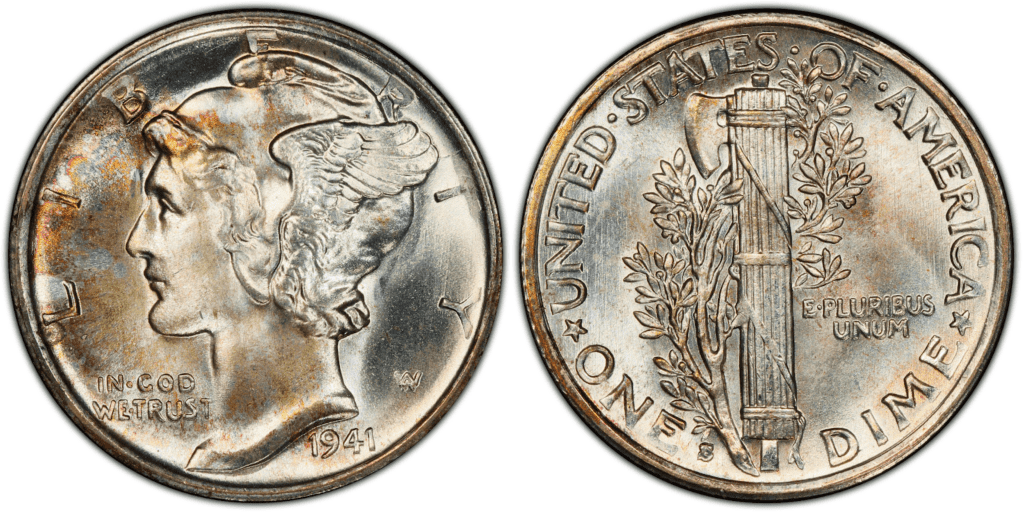
Repunched Mint mark (RPM)
A coin is referred to as a Repunched Mint Mark (RPM) variety when the repeated mint mark impressions come from the same mint mark. For instance, a D punched over a D, or an S punched over an S. In the example below, the “D” mint mark was repunched northwest of the first impression.
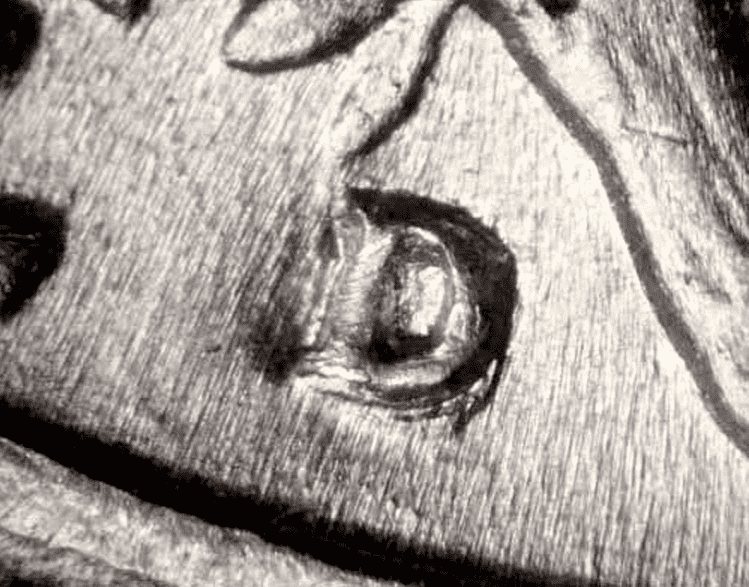
How Much Is The 1941 Mercury Dime Worth Today?
The Winged Liberty Head (Mercury) dime has a face value of $0.10 (10 cents). The NGC sets the melt value at $1.74.
USA Coin Book estimated its value at $2.77 in Average Condition. It can be worth $7.31 to $35 or more in Uncirculated (MS+) Mint Condition for the Philadelphia and San Francisco variants and up to $8.54 to $28 or more in Uncirculated (MS+) Mint Condition for the ones minted in Denver.
To appreciate the great potential of the 1941 mercury dime, take a look at this values chart that shows you the auction records based on the PCGS website:
| Coin | Condition | Grade | Sold date | Sold by | Value |
| 1941-S Mercury Dime | Superb Gem Uncirculated – Full Band | MS 68 | November 9, 2006 | Bowers & Merena | $28,175 |
| 1941-P Mercury Dime | Superb Gem Uncirculated – Full Band | MS 68 | September 26, 2019 | Legend Rare Coin Auctions | $17,625 |
| 1941 Proof Mercury Dime | Superb Gem Uncirculated – Full Band | PR 69 | February 23, 2020 | Heritage Auctions | $13,200 |
| 1941 Denver Mercury Dime | Superb Gem Uncirculated – Full Band | MS 68 | October 1, 2020 | Heritage Auctions | $5,290
|
How Does The Grading System Work?
The Sheldon Scale is used by numismatists to provide a numerical value to coins. The Sheldon Scale goes from poor (P-1) to perfect mint state (P-1) (MS-70). Coins were originally evaluated using words to reflect their condition (Good, Fair, Excellent, Etc.). Unfortunately, coin collectors and dealers had different ideas about what each of these terms represent.
Professional numismatists joined together in the 1970s and established CoinGrading standards. These numismatists now assign grades at key places on the seventy-point scale, using the most regularly utilized numeric points in conjunction with the original adjective grade. The following are the most common coin grades:
-
-
- (P-1) Poor – Indistinguishable and probably damaged; if used, must have a date and mintmark; otherwise, rather battered.
- (FR-2) Fair – Nearly smooth, but without the damage that a coin graded Poor often possesses. The coin must have enough detail to be identified.
- (G-4) Fair – Inscriptions have merged into the rims in some areas, and important elements have been mostly erased.
- (VG-8) Very Good- A little weathered, but all of the primary design elements are visible, albeit faintly. There is little if any, central detail left.
- (F-12) Good – The item is very worn, yet the wear is even, and the overall design details stand out clearly. Rims are almost completely isolated from the field.
- (VF-20) Very Fine – Moderately weathered, with some finer features still visible. The motto or all letters of LIBERTY are readable. Both sides of the coin have entire rims that are separated from the field.
- (EF-40) Extremely Fine – Gently used; all gadgets are visible, and the most important ones are bold. The finer details are bold and clear, however, light wear may be seen.
- (AU-50) Uncirculated – Slight evidence of wear on the coin’s design’s high points; may have contact marks; eye appeal should be adequate.
- (AU-58) Uncirculated Choice – Slight traces of wear, no severe contact marks, almost full mint shine, and great eye appeal.
- (MS-60) Mint State Basal – Strictly uncirculated; no indication of wear on the coin’s highest points, but an unsightly coin with reduced luster, visible contact marks, hairlines, and other flaws.
- (MS-63) Mint State Acceptable – Uncirculated, but with contact scratches and nicks, little reduced shine, but otherwise appealing appearance. The strike is weak to average.
- (MS-65) Mint State Choice – Uncirculated with great mint shine, very little contact blemishes, and exceptional eye appeal. The strike is unusually severe.
- (MS-68) Mint State Premium Quality – Uncirculated with superb luster, no obvious contact marks to the naked eye, and exceptional eye appeal. The strike is quick and appealing.
- (MS-69) Almost Perfect Mint State – Uncirculated with perfect brilliance, a sharp and appealing strike, and extremely good eye appeal. A near-perfect coin with minor imperfections in the planchet, strike, and contact markings (seen only under 8x magnification).
- (MS-70) Mint State Perfect – Under 8x magnification, there are no tiny imperfections discernible; the strike is crisp, and the coin is perfectly centered on a beautiful planchet. Rarely seen on a coin, this coin is bright and whole, with original luster and exceptional eye appeal.
-
Where To Buy Or Sell 1941 Mercury Dime?
Even if it is harder to find a 1941 Mercury dime in coin or antique shops, you may be able to find one there. However, with technology, you can now browse online and conveniently check for places to purchase these coins.
You can check out online markets, such as Amazon, eBay, Etsy, or Craigslist, to search for these dimes. You might even get lucky and find a seller with rare ones!
If you want to be sure about your purchases, you can also get advice from professional coin grading service providers such as the NGC or the PCGS. They can tell you where and how to buy or sell your 1941 Mercury dimes.
FAQs
How rare is a 1941 Mercury dime?
Coin collectors regard the 1941 Mercury dime as one of the most exquisite coins ever produced, but their value is still quite low because of its large mintage that year. However, older pieces in excellent condition are considered rare.
What is a 1941 silver Mercury dime worth?
According to USA Coin Book, the 1941 Mercury dime is valued at $2.77 in Average Condition and can be worth $7.31 to $35 or more in Uncirculated (MS+) Mint Condition. Proof coins can reach a value of up to $315.
How much is a 1941 Mercury dime in good condition worth?
A 1941 Mercury dime in Good Condition is worth $2.21.
